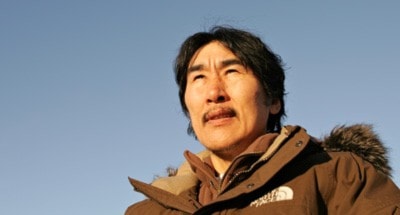Atanarjuat running naked through snow and overflow was the first thing that came to mind after learning Natar Ungalaq was in town.
But the Fast Runner star showed up at the local coffee shop in a North Face parka.
He didn’t even have bare feet.
Soft spoken and full of smiles, Ungalaq didn’t act like a film star.
In fact, it was hard to get him to talk about it.
Ungalaq was more interested in chatting about Igloolik, being Inuk and his art.
“For me, being an artist, I can’t sit in one seat all the time,” he said.
“I have to shift from one thing to another.”
It all began when he was nine.
Nabbing a file from his grandfather, Ungalaq started working with anything he could find.
“Stone, ivory, wood — I tried them all,” he said.
“I knew I was an artist.”
Growing up in the tiny Nunavut town of Igloolik, population 1,400, Ungalaq created his own opportunities.
“I was a broadcasting host,” he said.
“And I made programs like talk shows with elders performing cultural ceremonies.”
The video camera belonged to his long-time friend Zacharias Kunuk, who later created Atanarjuat the Fast Runner.
Still young, Kunuk and Ungalaq went to Montreal to exhibit some art and after selling a few pieces, Kunuk took the cash and bought the camera.
“It cost too much money, so I’d rather see him buy it,” said Ungalaq with a laugh.
“And I said, ‘Let’s see if you’re successful and I’ll be there for you.’”
Six Genies and 12 awards later, the pair is still working together.
Kunuk writes his films collaboratively, but Ungalaq stays away from this part of the process.
“I tried to do both (the writing and acting) and it’s too much work,” he said.
Kunuk isn’t a traditional filmmaker. His scripts are only partially written before the shooting begins.
“It all flows,” said Ungalaq.
“We practise by action.”
If the script is 80 pages, there are 80 puzzles, he said.
“And we have to fit them all together.”
The friends started making films to showcase the North.
“We wanted to lift up our untold stories,” said Ungalaq, mentioning the Fast Runner is based on a popular Inuit legend.
“We just wanted the experience of filmmaking — and we actually made a good one.”
Acting came naturally to Ungalaq who grew up listening to his grandmother’s stories.
“I understand acting through storytelling,” he said.
“As a kid she would tell me happy stories and sad stories. And there were some stories where she would tell me I would have to wait until I was an adult until I could hear certain parts.”
As a teen, Ungalaq began to hear some of these adult stories.
“Those verbal stories were my main TV,” he said.
When he was little, Ungalaq grew up in a sod igloo, living off the land with his family.
“It was made of whatever we could grab, moss, rocks, grass, plywood,” he said.
But by the time he was 10, the whole family had moved into Igloolik.
“Education brought us to the settlement,” he said.
And although a lot of Inuit had bad experiences at the government schools, Ungalaq didn’t lay blame.
“A lot of people say the whites came and invaded, but it was us who chose to go,” he said.
“We started living in these wooden houses and they were warm and good for us.”
But with the houses came other problems.
Rent was originally whatever a family could afford, maybe $2 a month, said Ungalaq.
Now, it’s $2,700 a month.
“If you look at the rates in the South and in the North, they don’t match,” he said.
“It’s three times higher up here.”
So are youth suicide rates.
The day after Ungalaq arrived in the Yukon, another youth in Igloolik committed suicide.
“There’s no way to solve it right away,” he said.
“But we need to get some action instead of talking about it.”
Ungalaq is working with youth on video and TV projects, but recognizes the need for more facilities and tools.
“I started from the dust of making art with soapstone and I pass that on to young people, to teach them to start where I started,” he said.
“But we can’t take all the youth to one place.”
Small, isolated communities didn’t always suffer problems like suicide, and Ungalaq blames the rapidly changing culture.
“We’ve adapted to a different culture in 40 to 50 years,” he said.
“We used to live in groups of family and now there’s one pile with many families gathered together.”
Ungalaq was in Whitehorse to promote his newest film, The Journals of Knud Rasmussen, also co-written and directed by Kunuk.
Set in 1922 Igloolik, the film chronicles the influence of Christianity as it sweeps through Inuit cultures in the north.
And in it, Ungalaq gets to wear caribou skins again.
“That’s one of coolest things,” he said with a grin.
“And you can cheat a little bit, and wear T-shirts and long johns underneath to defend the hair from your skin.”
Ungalaq also cheated when he sprinted naked across the Arctic ice in the Fast Runner.
He had fake feet.
“I wore rubber feet to defend my feet,” he said with another grin.
“They came from down south.”
Ungalaq is currently working on another film and spends a fair bit of time away form his northern home.
But he will always return to the North, he said.
“For me it is more a cord you are anchored by.
“I love to travel, but I am not going to cut my cord.”
